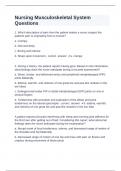Exam (elaborations)
Nursing Musculoskeletal System Questions and answers rated A+
- Course
- Institution
Nursing Musculoskeletal System Questions and answers rated A+ 1. Which description of pain from the patient makes a nurse suspect the patients pain is originating from a muscle? a. Crampy b. Dull and deep c. Boring and intense d. Sharp upon movement - correct answer a. crampy 3. During a...
[Show more]



